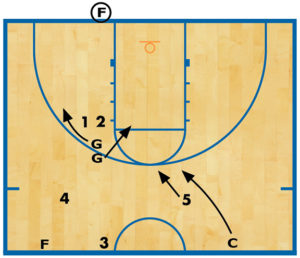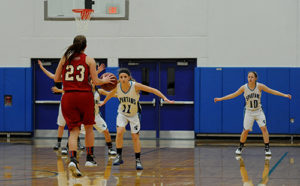’10’ defense shuts down inside-out game
The “10” defense a versatile, stifling 1-2-2 zone defense that can immediately become a 2-3 zone the instant that the ball is passed to the wing.
It takes away 3-pointers on the wing as well as a 1-2-2 zone does, and it also protects the middle from quick passes to the inside.
Another great aspect to this defense is that ball reversals don’t hurt your team in this alignment, because the same defender covers the wing every time.
Basic defensive rotations
Here are the basic defensive rotations for the “10” defense. Once your players have the rotations and responsibilities memorized, the “10” defense becomes very effective.
DIAGRAM 1: This is the initial defensive set. X1 calls “ball” and covers the point. X4 and X5 remain just inside the low blocks and keep opponents out of the lane. X2 and X3 are positioned just past the elbows extended. All defenders watch to see where the first entry pass is going.

DIAGRAM 2: When the pass goes to the wing, X3 calls “ball” and goes out to cover the opponent. X5 fronts the post opponent and gets ready to cover the possible pass to the corner. X4 slides over to protect the middle. X2 drops back and boxes out on the weak-side post. X1 drops to the free-throw line.
DIAGRAM 3: When the ball is passed into the corner X5 calls “ball” and covers the player with the ball in the corner. X4 will drop behind the post and get help from X3 who drops down slightly. X2 continues to box out the post on the weak side and X1 rotates up and down the center line guarding the lane.

DIAGRAM 4: X4 and X5 need to be “up-and-in” the lane when the ball is on top in order to protect the middle. These defenders also have direct lane-to-corner responsibility on passes to the deep corners.

DIAGRAM 5: If the ball is skip-passed cross court, the closest defender takes the ball and the rest of the defenders get back into the defensive rotation as soon as possible.
If your opponents begin to rely on low-percentage cross-court passes, it will work in your team’s favor.












